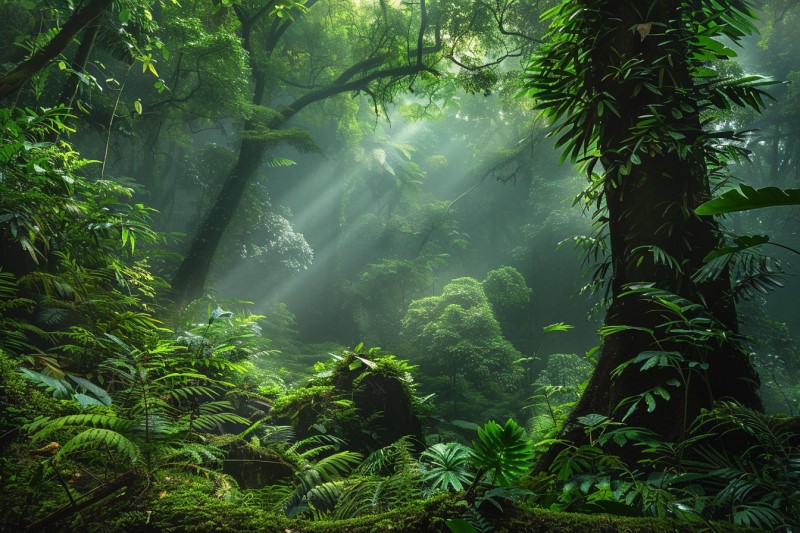KidZone Habitats
Types of Habitats
Just like we live in different kinds of houses - some of us in tall buildings, some in cozy cottages, and others in sprawling houses - animals and plants have their own special kinds of homes called habitats. Each habitat is unique and has everything its residents need to survive. Let's explore some of the amazing habitats our planet has to offer!
- Forests: Imagine walking through a big, green forest, full of tall trees that reach up to the sky. Forests are like nature's skyscrapers, providing lots of layers from the ground to the treetops, each layer home to different animals and plants. Squirrels might play in the branches, while deer roam the forest floor.

- Deserts: Deserts are like the sandy beaches of the ocean, but without the water. They're very dry, but still full of life! Cacti store water in their thick stems, and animals like lizards and camels are experts at staying cool and finding water to drink.
- Oceans: The ocean is like a vast, blue water world, deeper and bigger than most of us can imagine! It's home to many different creatures, from tiny fish and colorful coral reefs near the surface to mysterious animals in the deep, dark waters below.
- Rainforests: Rainforests are the world's biggest gardens, with so many plants that the air feels wet. They're full of life, with bright birds, chattering monkeys, and even sneaky jaguars. The tall trees form a thick roof called a canopy, which keeps the forest underneath shady and damp.

- Tundras: The tundra is like a cold desert, with wide-open spaces and not many trees. It's chilly, especially because it's so close to the top and bottom of the Earth. In the tundra, you might find animals with thick fur coats, like arctic foxes and reindeer, who are well-suited to the cold.
- Mountains: Mountains are like towering giants of the Earth, standing so tall that their peaks can be covered in clouds! In these high places, animals such as mountain goats and eagles make their homes, braving the thin air and navigating the rocky terrain.
Each of these habitats is like a different neighborhood in our big, beautiful Earth community. Animals and plants pick their homes based on what they need to survive, whether it's lots of water, tall trees to hide in, or wide-open spaces to roam. Isn't it amazing how many different kinds of homes there are in the world?
The list provided focuses on general and iconic habitats, such as "Forests," "Deserts," "Oceans," "Rainforests," "Tundras," and "Mountains." This selection is excellent for younger children or introductory lessons, as it covers broad categories that are easy to understand and visualize. These habitats often feature prominently in children's media and stories, making them more relatable and engaging for a younger audience.
How many habitats are there?
Think of our planet like a giant patchwork quilt, with each patch being a different kind of home for plants and animals. These homes are what we call habitats. There are big patches like forests, deserts, oceans, and mountains. But if you look closer, you'll see that each big patch is made up of lots of smaller patches, all a little different from each other.
For example, in the big "forest" patch, there are a number of smaller habitats you can explore:
- Under a Log: Underneath a fallen log, you might find a cool, damp mini habitat where bugs, worms, and fungi like to live. It's like a little bug hotel hidden away from the rest of the forest!
- Streamside: Along the side of a stream running through the forest, there's a wet and lush area where certain plants love to grow, and animals like frogs and dragonflies hang out.
- Tree Canopy: High up in the tree branches, there's a whole other world! Birds build nests here, and squirrels zip from tree to tree.
- Forest Floor: The ground of the forest, covered in leaves and soil, is another subhabitat. It's home to plants that don't need much sunlight, and animals like deer might come to browse on the low-growing plants.
Each of these mini habitats inside the forest has just what certain plants and animals need to be happy, like their own special room in a big house. A big habitat like a forest is full of all sorts of smaller patches -- specialized subhabitats for lots of different creatures!
People have made new patches too, like cities, farms, and parks, where some animals and plants have learned to live. And just like your quilt might get new patches or change over time, habitats can change too because of things like the weather or what people do.
So, it's hard to say exactly how many habitats there are, because there are so many, and they're always changing and mixing together. Isn't it cool how many different homes our Earth has?
Other links you might enjoy:
- DLTK's Habitat Craft (crafts, coloring, recipes and more)
- Habitats Coloring Pages - includes different plant and animal species
- Kidzone Geography - includes different plant and animal species